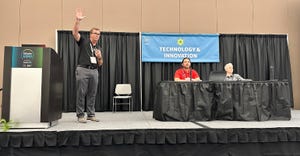Los Angeles Recycling: The Next Generation
November 1, 1996
Bill Knapp and Daniel Hackney
The City of Los Angeles unveiled its "Second Generation Recycling Program," in mid-October at a meeting with industry equipment suppliers.
The Los Angeles Sanitation Bureau's Recycling Division hosted the event which was held at the city library and attracted approximately 55 manufacturers.
The Second Generation Team, including Assistant Director Drew Sones, Manager John Delarosa and Engineering Manager Enrique Zaldivar, described the results of the recently completed automated recycling program, which tested new trucks and containers as well as new ways to stimulate public participation (see "Automation '96: It's Recycling's Turn," World Wastes, February 1996, page 20).
Based on these pilots, the city will begin a single stream, fully- automated recycling collection program early next year. Semi-automated collection will be used in areas inaccessible by fully-automated trucks.
While each of the city's six districts would be bid separately for containers, it is accepting only one bid for vehicles. The city panel emphasized that the cart request was a departure in that it demanded a uniform product - one of similar shape and color (blue) - regardless of bidder, for possibly $30 million worth of containers.
Bids would be returned in three weeks, and lowest price would be the only criterion. This, too is a departure from past purchases, where requests for proposals were the norm.
During the meeting, Sones said that the city may require that the carts contain as much as 30 percent post-consumer plastic used throughout the container and not only in the lid. Manufacturers said that this demand could be met by using post-consumer plastic collected through the city's recycling program.
The 50 percent diversion goal of State Assembly Bill AB939, plus the increasing cost of diversion prompted the bureau to increase both public participation and the amount of recyclables set out.
The city's first generation recycling program began in September 1990 using manual collection of a 16-gallon yellow bin. However, such efforts have resulted in a significant scavenging problem.
The bureau began an automated collection pilot project in April 1996, which tested three containerized collection methods using a blue 90-gallon container:
* single stream or fully commingled;
* a hybrid with the paper stream loose and the commingled cans and bottles in a 30-gallon bag; and
* split stream, with the paper on one side of the container and commingled cans and bottles on the other.
Fifteen pilot routes were selected, five per each collection method. The automated containers were an immediate success. Participation in set-out rates and tonnage collected doubled to tripled over existing levels in all fifteen routes.
While the data from all three automated collection methods were encouraging, the hybrid method lagged behind the other two and led to increased scavenging of the pre-bagged cans and bottles. That pilot was suspended in August, and the five routes were converted to single-stream collection.
To date, the single-stream meth-od led in participation and tonnage, while also displaying the best results in deterring scavengers who would be forced to sift through a 90-gallon container. Many neighborhoods have reported that scavengers have disappeared since the introduction of the "blue containers."
In a recent survey, the bureau found that 93 percent of customers in the pilot program expressed satisfaction with the automated collection of recyclables in the 90-gallon blue container. (More than 30 percent completed and returned their surveys.)
With that approval rating, the bureau, with the encouragement of the Mayor's Office, members of the City Council and the Board of Public Works, is expediting original time lines and is optimistic that the first Second Generation containers will be distributed as early as January l997.
The City of Los Angeles sanitation bureau serves a total of 720,000 households.
You May Also Like


